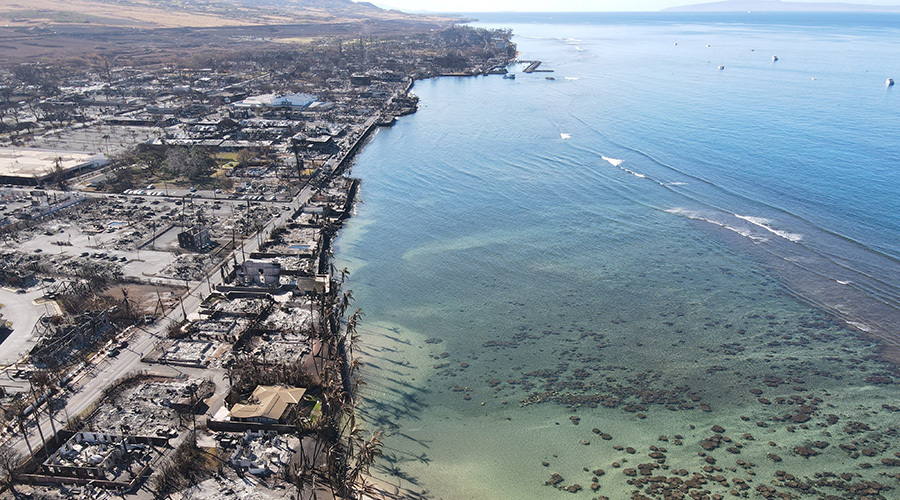 Robert Cowan Director of Facilities, Fred Hutchinson Cancer Research Center, Seattle. Tim Ryan Director of Facilities, Burlingame (Calif.) School District.
Robert Cowan Director of Facilities, Fred Hutchinson Cancer Research Center, Seattle. Tim Ryan Director of Facilities, Burlingame (Calif.) School District.Emergency Preparedness: Managers Discuss Efforts to Protect Occupants and Operations in a Crisis
As facilities evolve and the list of potential crises grow, managers upgrade efforts to protect occupants and operations.
By Dan Hounsell, Editor-in-Chief
OTHER PARTS OF THIS ARTICLEPt. 1: This Page
The nature of potential crises that could affect institutional and commercial facilities has evolved in recent years. From active shooters to data-center technology, a growing list of potential emergencies are testing the funding, planning and training strategies that maintenance and engineering managers must help develop and put in place to protect occupants, operations and facilities.
Please describe your role and your department’s role in emergency preparation and response.
Cowan: We have two processes here. One is a comprehensive emergency management plan that dictates what we do in an emergency. We also have a business continuity plan that steps in after the emergency management plan is over to help us with life after the disaster. My role is running the facilities engineering side of the equation related to assessing facilities, finding out where problems are, and getting the resources to the priority problems to get them resolved in a timely manner. We continually look at our priorities, and we are in continuous discussions so that our priorities for emergency response are in line with the needs of the center. Depending on the nature of the emergency, facilities engineering is almost the bedrock that all response is built upon. We do the hazard-risk analysis trying to identify the most likely risks and the probability of those risks occurring. In virtually all of those areas — recovery from natural disasters — engineering is the primary player in the game.
Ryan: My primary function is with the capital-improvement side doing improvements to campuses, but I do have my hand in operations and have worked with local fire and police and with school administrators on improving our response to emergencies. Since (the) Sandy Hook (school shooting in 2012), there has been a reinvigorated approach to people looking at the security and safety of our campuses in ways that were easily overlooked by our community in the past and are now requested. Our assistant superintendent for business services and I work with the county in implementing what we call the “big five” approach to our drills and our preparations for our districts: shelter in place; drop, cover and hold on; secure campus; lock down barricade, and evacuation.
How have these roles evolved in response to changes in your facilities?
Cowan: A couple of big things have happened to us since I started here 19 years ago. First, we started treating patients that we didn’t treat years ago. Second, we added a lot of server rooms and the new technology supporting those server rooms. So we had to add the patients and server rooms into our priority list.
Ryan: I’ve been in this county for four years, and this is a much more populated, dense community, so there seems to be more response available from local professionals. There has been a lot of time working with them, whereas with my previous district, you worked on your own response because they weren’t sure they’d be able to offer as much assistance as I’m getting here.
What types of potential emergencies are the highest priorities for your facilities?
Ryan: It used to be that our primary focus was seismic, but it now has become more commonplace that we prepare our physical sites by keeping material from falling and attaching furniture to walls. We needed to work more on staff training for sheltering in place, securing the campus, lock down and barricades. With fire, you have your monthly drills where you practice the evacuation of your school site. It’s not that seismic and fire have been relegated to a lesser position. It’s that others have been raised to be more equal. That’s why it’s not just a fire focus or just a seismic focus. We are a wildlife-urban-interface, or WUI, area. You have different requirements for your facilities from the state agencies, depending on your location and the level of fire protection you need to have, the type of plaster you’re allowed, and the type of skylights you have. All are based on your geographic location in a wildlife-urban interface.
Cowan: The four emergencies that we do most of the drilling and preparation for are power outages, fires, earthquakes and severe weather. Earthquakes are a high priority that we prepare for on a regular basis. In the Northwest, it’s not a question of if an earthquake is going to happen. It’s a question of when it’s going to happen.
What are your biggest challenges in preparing facilities for a possible emergency?
Ryan: Having the funds available to make the improvements we want to make. When I came to the district four years ago, our facilities were wide open. There were no gates, and there were no locks. One of the first projects I was tasked to do using our capital-improvement bonds was to add fencing and gates. The next step is more control, where gates are locked. We’re going to be adding call buttons and door releases at gates. So the challenge is to find the funds, find the time. First, we put up the fence, and then there is the normalization so people just accept that that’s just how school is now. The next step is adding gates that have push-button calls so the front desk can use the video feed to see who’s at the gate and release them into the campus. The goal is to create a sense of security without creating a sense of fear. Many of the post-World-War-II schools put the entrances into the front offices. New schools and new facilities are designed to have entry points as you arrive at the campus. So I have a number of facilities where to even get to the office, you have to walk up the stairs and down the hall, or you have to walk through a campus to a door. So this next phase of putting in call buttons and door releases will help us identify who’s on campus. As you know with Sandy Hook, they had all that. It’s not preventative, but it’ll increase our ability to know who’s visiting our campus.
Cowan: Because of the nature of our business, nothing is going to work without electricity, so we’ve taken that extra step to make sure our electricity supply is as reliable as possible. We like to say that if you don’t have a good Plan B, you better have a good resume. We spend a lot of time looking at our Plan Bs. We have eight generators on campus, and we can produce 9 megawatts of power. But we recognize that even though we do all the required PMs on them and test them and automatic transfer switches regularly, it’s not guaranteed that they’re going to start in an emergency. So we have quick connection points — tap boxes — on our major facilities, and we have a portable generator. If something were to occur, we could roll out the portable generator and back up that emergency power system. We also have a battery jump cart because we know that 60 percent of failure-to-start issues with generators are related to batteries. We also don’t believe in running our gear to failure. Our philosophy is that we’d rather replace a piece of equipment a year too early than a year too late. For instance, we’ve replaced four automatic transfer switches in the last three years as they’ve reached end of life. We test our circuit breakers. We bring in a team and test the trip settings and the coordination on our circuit breakers. We do maintenance on our regular switchgear. We also use the automatic transfer switches to initiate the load for the generator, and we transfer the load for each of our monthly generator tests. We don’t just run the generator.
What is your role in securing equipment for facility recovery?
Cowan: Over the last 10 years, we convinced the center that a $90,000 portable generator was is a good investment. We also convinced the center that having cable to allow us to hook up that generator was a good investment. We also convinced the center to buy three 15-ton portable cooling units. We’ve built redundancy into our systems. We have a critical facility that needs three air handlers to keep it cool, and we convinced the center that a fourth air handler was a good investment.
Ryan: Our San Mateo County Schools Insurance Group is my point of contact for emergency response and recovery, and we’ve had flooding and campuses that have had mudslides. We’ve had to pull carpet and drywall. This winter saw the most water in California in 122 years. We had flooding that was a 400-year event. So the response equipment is dehumidifiers and blowers for drying and sump pumps to move water out.
Has your organization faced an emergency in recent years?
Cowan: In 2001, we had a fairly significant earthquake, and every year we seem to have a power outage or two. We had a two-hour power outage throughout campus a couple of months ago. One of the things we did in a big capital project is bring a second feeder into our campus. Unfortunately, both feeders went down (in the outage), and the campus was without power. Our preparation was fairly good. When the disaster hit, rather than the guys trying to figure out what they’re supposed to do, everyone has a pre assigned mission, with sufficient backups, redundancy and flexibility in case someone is unavailable during the actual emergency. This allows an immediate response, so rather than people trying to figure out what they are supposed to do and waiting for someone to assign them action, they know what they are supposed to do and can react immediately. We have some teams that go out and assess the situation, and other teams are devoted to major pieces of equipment to make sure they are running. We’ve redesigned our energy management control system, or building automation system. With most systems, in an emergency, you get hundreds if not thousands of red lines from pieces of equipment that aren’t working. We’ve taken a different approach. We have a situational-awareness board, so by building, we know about each piece of equipment. So at a glance, we can see where our problems are.
What are your organization’s next steps in preparing for emergencies?
Ryan: Our next phase is installing call buttons on our front doors. In having gates at our schools, we have directed everyone to a single point of entry, and now it’s time to control that single point of entry with two-way communication. We push out the school emergency guidelines to our staff. But pushing it out is just one thing. Reviewing it with them is the next step: making sure they all understand that they’re all emergency service workers. Should there be an event, there are expectations for their actions and behaviors.
Cowan: The center is moving past the emergency response plan into the business continuity plan, and the department is participating in that. If a disaster hits and we’re at reduced capacity, we want to be able to keep key functions going, either here or remotely. Plans are nothing. Planning is everything. We’ve walked through 36 different emergency scenarios, and we have plans for those scenarios, from sump pump failure to generator failure. When an emergency happens, those written plans are just the basis, and you have to adjust to the situation. But going through that planning process helps us identify our weak spots.
Related Topics:












